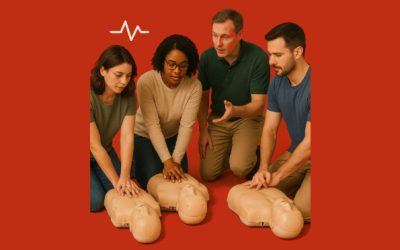In emergency situations, being able to perform CPR (Cardiopulmonary Resuscitation) and use an AED (Automated External Defibrillator) can mean the difference between life and death. Whether you’re a parent, teacher, or healthcare provider, CPR and AED training is an essential skill that can help save lives. If you’re planning to take a CPR and AED certification course in Phoenix, it’s important to know what to expect during the course.
In this blog post, we’ll walk you through the key components of a typical CPR training course, including what you’ll learn, the skills you’ll practice, and how to prepare for certification. This will help ensure you’re fully prepared for the course and ready to handle an emergency situation.
What is CPR and AED Certification?
CPR and AED certification is designed to teach individuals how to perform CPR and effectively use an AED to help someone experiencing a medical emergency, such as cardiac arrest. This training is essential for anyone who wants to be prepared to help in a life-threatening situation.
In a CPR and AED certification course, you’ll learn the essential steps needed to help keep someone alive until medical professionals arrive on the scene. These classes teach both basic CPR skills, such as chest compressions and rescue breathing, and the use of an AED, a device that can restore a normal heart rhythm during cardiac arrest.
What You’ll Learn in a CPR and AED Certification Course
1. Understanding CPR Basics
The first section of your CPR training course will focus on the fundamental skills needed to perform CPR correctly. You’ll learn about:
- Chest compressions: The correct depth and rate for chest compressions to circulate blood effectively.
- Rescue breathing: How to provide rescue breaths for someone who isn’t breathing on their own.
- Compression-to-breath ratio: The proper ratio of chest compressions to breaths, typically 30:2 for adults.
These techniques are essential for helping to maintain blood flow and oxygen to vital organs when a person is in cardiac arrest. You’ll also learn how to assess the situation and determine when and how to begin CPR.
2. Using an AED (Automated External Defibrillator)
In addition to CPR, you’ll also learn how to use an AED—a critical tool in emergency situations. An AED can detect a person’s heart rhythm and deliver a shock if needed to restore a normal heart rate. During your CPR and AED certification course, you’ll gain hands-on practice with the AED and learn how to:
- Place AED pads on the victim’s chest.
- Turn on the AED and follow the prompts.
- Administer a shock if needed to restart the heart rhythm.
It’s important to note that AEDs are designed for ease of use, with voice prompts guiding you through each step of the process.
3. Recognizing and Managing Different Emergencies
Your course will also cover different types of medical emergencies and how to respond appropriately. This includes:
- Cardiac arrest: The primary focus of CPR and AED use.
- Choking: Techniques for clearing a blocked airway, including abdominal thrusts (the Heimlich maneuver).
- Breathing emergencies: How to help someone who is struggling to breathe or is unconscious.
These skills are important for healthcare providers, teachers, parents, and anyone who may find themselves in a position to help in an emergency situation.
The Course Format: What to Expect
1. Hands-On Practice
A significant portion of any CPR training course involves hands-on practice. CPR isn’t something you can learn just by reading or watching videos. To become proficient in these life-saving skills, you must practice the techniques on manikins, just as you would in an actual emergency.
During the course, you’ll:
- Perform CPR on adult, child, and infant manikins to learn the correct compression techniques.
- Use an AED trainer to get familiar with how to use the device in a real emergency.
- Practice rescue breathing and choking procedures.
This hands-on experience is crucial to building confidence and ensuring you can perform these techniques effectively in a real emergency.
2. Written and Skills Test
To receive your CPR certification, most courses will require you to complete a written test and demonstrate your skills. The written test will assess your understanding of the material covered, while the skills test will require you to perform CPR, use the AED, and handle various emergency scenarios under supervision.
You don’t need to be nervous about the test—many training centers offer practice exams, and the goal is to ensure you’re comfortable with the techniques and know what to do in an emergency. After successfully completing the course and tests, you’ll receive your certification, which is usually valid for two years.
3. Certification Card
Upon successful completion of the CPR and AED course, you’ll receive a certification card. This card demonstrates that you are trained in CPR and AED use, and it may be required for certain jobs or volunteer positions. The certification card typically includes the date of issue and the expiration date, which means you’ll need to renew your certification every two years.
How to Find CPR Training Near Me
If you’re in Phoenix, AZ, you can find CPR training courses at various local centers. Many courses are offered by organizations like the American Heart Association (AHA) or Red Cross, and several authorized training centers in Phoenix offer courses throughout the year.
For example, you can find a CPR and AED certification course at an authorized training center in your area, where you’ll receive hands-on practice and certification that meets the latest guidelines. Whether you’re looking for courses in person or online, ensure you choose a reputable provider that follows industry standards.
Be Prepared for the Unexpected
Taking a CPR and AED certification course is one of the best ways to be prepared for a medical emergency. By learning life-saving skills like CPR, AED use, and how to manage choking and breathing emergencies, you’re equipping yourself with the knowledge needed to help someone in a crisis. In Phoenix, there are numerous opportunities to take CPR training courses and earn your certification, so don’t wait—sign up for a course today and become a life-saver.


